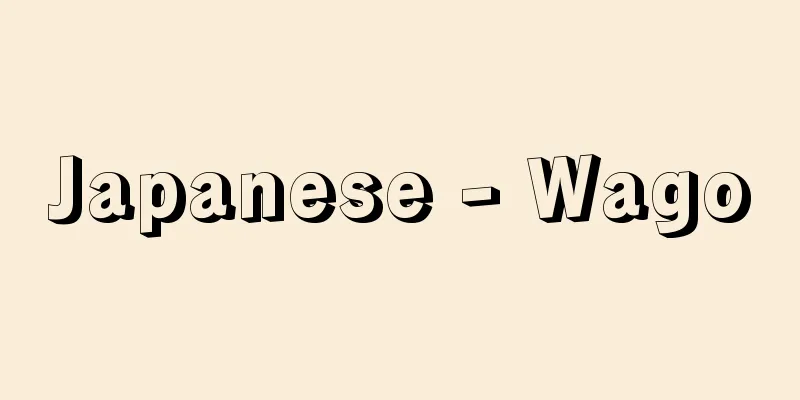Japanese - Wago

|
Native Japanese words, as opposed to Chinese words and foreign words. Also called "Yamato kotoba." Originally, the first syllable does not have a voiced consonant or rarirurero. Daku (embracing) is a word form that evolved from idaku, and bara (rose) is a word form that evolved after the Middle Ages. Japanese words tend to be one- or two-syllable words, such as "tree," "blood," "valley," "listen," and "see," and the number of words increases through compounding. Compound words consist of a Japanese word and a Japanese word or a prefix or suffix, and the initial sound of the lower word may become a voiced consonant (e.g., valley (tani) river (gawa)). Also, the final sound of the upper word may change (e.g., sake (sake) → sake (sakaya)). Japanese words may be compounded with Chinese words. Words with Chinese characters at the top (e.g. akudama (bad guy), engumi (marriage), etc.) are called jubakoyomi (junior box reading), and words with Japanese characters at the top (e.g. aikyaku (guest), uijin (first battle), etc.) are called yutoyomi (bad bucket reading). They can also be combined with foreign words (e.g. 'eraser', 'matchbox', etc.). Japanese words include non-inflected words (nouns, adverbs, particles, etc.) and inflected words (verbs, adjectives, auxiliary verbs, etc.), but Chinese and foreign words are mainly limited to non-inflected words such as nouns and adjectival verb stems, and can only become predicates or modifiers by adding the Japanese words 'suru' (do) or 'da' (written words are 'su' (su), 'nari' (nari), and 'tari'). Inflected endings, auxiliary verbs, and particles are all Japanese words, and Japanese words dominate the core of grammatical functions, and this characteristic has been consistent from ancient times to the present. In the Heian period, the number of Japanese words was about 90% in Japanese texts and less than 40% in Chinese readings. Since the end of the Middle Ages, European words have increased, and in the early Meiji period, Chinese words have increased. Recently, the number of foreign words in English has increased rapidly, but Japanese words have maintained their grammatical function without any change. [Yutaka Tsukishima] Source: Shogakukan Encyclopedia Nipponica About Encyclopedia Nipponica Information | Legend |
|
漢語・外来語に対し、日本語本来の語。「やまとことば」ともいう。本来、第一音節には濁音およびラリルレロが来ない。ダク(抱)はイダク等、バラ(薔薇)はウバラ等から、中古以後転成した語形である。和語は、「木(き)」「血(ち)」「谷(たに)」「聞(き)く」「見(み)る」など1、2音節語が多く、複合によって語が増加する。複合語は和語と和語または接頭語・接尾語とからなり、下の語の頭音が濁音化することがある(例、谷〈たに〉川〈がわ〉)。また、上の語の末尾の音が変わることがある(例、酒〈さけ〉→酒〈さか〉屋)。和語は漢語と複合することがある。漢語が上のもの(例、悪玉〈あくだま〉、縁組〈えんぐみ〉等)を重箱読(じゅうばこよみ)、和語が上のもの(例、相客〈あいきゃく〉、初陣〈ういじん〉等)を湯桶読(ゆとうよみ)という。外来語との複合もある(例、「消しゴム」「マッチ箱」等)。和語には活用のない語(体言・副詞・助詞等)と、活用のある語(動詞・形容詞・助動詞等)とがあるが、漢語・外来語はおもに名詞・形容動詞語幹等、活用のない語に限られ、和語の「する」「だ」(文語は「す」「なり」「たり」)をつけて初めて述語・修飾語となりうる。活用語尾・助動詞・助詞はすべて和語であり、文法機能の中枢は和語が独占し、この性格は古代から現代まで一貫している。和語の異なり語数は平安時代には和文で約9割、漢文訓読文で4割以下であった。中世末以来欧州諸語が、明治初期に漢語が増加し、近時は英語の外来語が急増しているが、和語が文法機能を堅持している点はすこしも変わらない。 [築島 裕] 出典 小学館 日本大百科全書(ニッポニカ)日本大百科全書(ニッポニカ)について 情報 | 凡例 |
>>: Wagenseil - Georg Christoph Wagenseil
Recommend
Ikhnaton (English spelling)
Date of birth and death unknown. The tenth king o...
Molnár Ferenc (English spelling)
Hungarian playwright and novelist. Born in Budape...
Rocco, Alfredo
Born: September 9, 1875 in Naples Died August 28, ...
"Climatology Handbook"
…In this sense, Hahn is called the father of clim...
Theory of the formation of the universe
…In this case, there were two opposing views amon...
Kirman - Kirman
...Population: 350,000 (1994). Also called Kirman...
Cheers - Cheers
...A singer who left the greatest mark on the his...
Nice - Nice (English spelling)
It is the capital of the Alpes-Maritimes departme...
Masatoshi Okochi - Masatoshi Okochi
Mechanical engineer and businessman. Born in Toky...
Sagamihara [city] - Sagamihara
The city is located in the central-northern part o...
Subkī (English spelling)
1327‐70 Egyptian writer. Born into the prestigious...
Caracci, L.
…An Italian family of painters. They overcame Man...
Table - Front
[1] [noun] (same etymology as "omote (face)&q...
Pedestrian - Gyonin
It means a person who practices asceticism, and i...
Oncidium sphaceratum
...About 500 species are distributed from the Wes...









